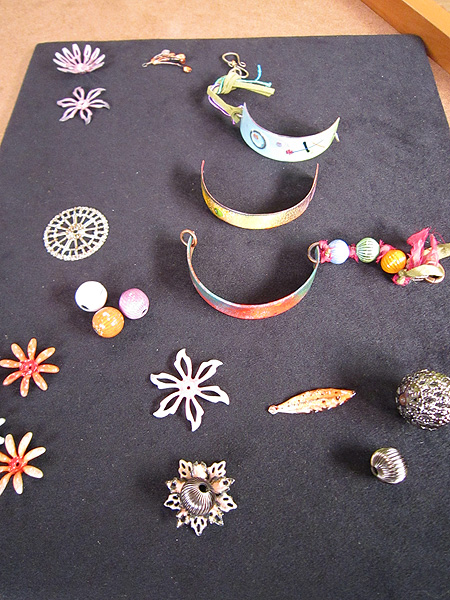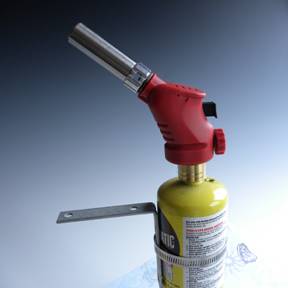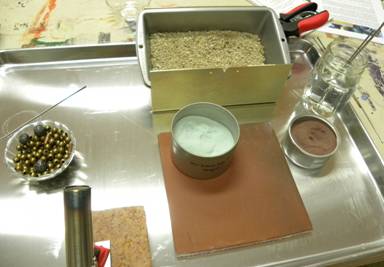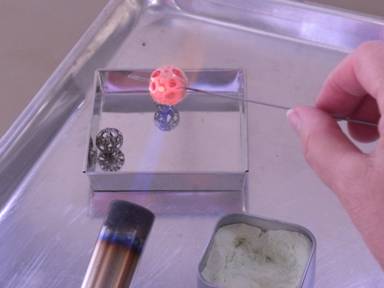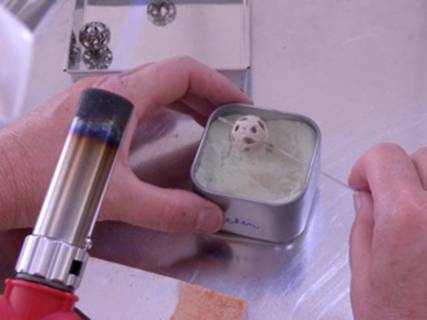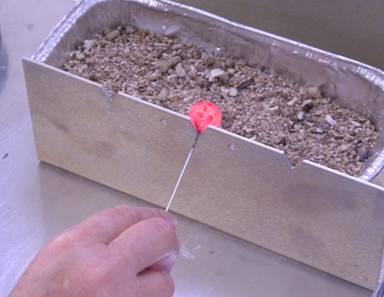 |
www.beadsbaublesandjewels.com |
| 1608-2 | Print | Close [X] |
Always wear safety eyewear when using all mechanical tools. Follow manufacturers’ instructions when working with tools and torches. What makes the Painting with Fire technique of torch firing so special? I love teaching Painting with Fire (PWF) workshops because I get high off the enthusiasm of my students! Who wouldn’t love to see a stream of happy faces leave a workshop? Can you imagine enameling 50 beads in an afternoon as a rank beginner? How about enameling a bead in 40 seconds? No, I’m not crazy! It’s a simple technique and easy to learn. It’s also affordable because there are few tools involved and the ones needed are inexpensive. Let me walk you through the technique.
The rest of the workstation looks like this … Put an iron or copper bead on the mandrel. Heat the bead in the flame. When it glows orange, immerse the bead in enamel and tap the mandrel on the side of the metal container to remove the excess enamel. Repeat the heating and dipping process two more times. Remove the bead by pulling it off the mandrel at the bead pulling station. That’s it! There’s no cleaning or pickling of the metal because the heat does that for us. No Klyr-fire or other fixative is necessary because the enamel immediately begins to fuse to the hot metal when the two come in contact. We’ve just eliminated two very time-consuming and tedious steps that are necessary in other types of torch firing. Harem Materials Preparing Fabric Establish the straight of grain: Use scissors to place a snip into the selvedge edge of woven fabric, about 1" (2.54cm) from the cut edge. (The selvedge edges are the two finished edges of the fabric as it comes from the factory.) Tear the fabric at the snip. 1. Use the directions at left to establish the straight of grain and the bias grain for ¼ yard (0.23m) of woven fabric. Cut through the ironed fold in the fabric. 2. Measure and mark 1" (2.54cm) from the cut edge along the length of the fabric. Cut a 15" (38.1cm) bias strip. 3. Spray adhesive on a 1⁄4" × 7" (6mm × 17.78cm) piece of foam tubing. Starting at one end and working across, wrap the bias strip around the foam. 4. Enamel four 12mm corrugated beads: one in White with Lime Yellow on top, one in White with Turquoise on top, one in Pumpkin and one in Clover (see Torch-Firing Beads on page 16). Enamel two 17mm flower bead caps in Pumpkin and Clover. 5. Thread a 4" (10.16cm) segment of 22-gauge sterling silver wire through a solid jump ring and make a wrapped loop. Thread a bead cap, an enamel bead and another bead cap onto the wire. 6. Make a wrapped loop flush against the bead cap, but before finishing it, attach a small rhinestone dangle link (see Making Wrapped Loops on page 25). Wrap the loop with the excess wire. Create six dangles.You can choose to add different enamel and manufactured findings to the dangles as desired. Go wild! 7. Wrap a bundle of ribbon and fiber strands around the tubing, starting 1" (2.54cm) from the end. Tie the ends in overhand knots to secure. 8. Slide a dangle onto the bracelet. Wrap another ribbon and fiber bundle after the first dangle to keep it from sliding on the bracelet. Continue sliding on dangles and wrapping bundles on the bracelet, stopping 1" (2.54cm) from the end and ending with a ribbon and fiber bundle. 9. Pierce the end of the foam bracelet with 3" (7.62cm) of 19-gauge annealed steel wire. Fold the ends up, keeping one end longer than the other. Wrap the shorter wire end around the longer wire end. 10. Thread an enamel bead cap onto the wire. Trim the excess wire and make a simple loop flush against the bead cap (see Making Simple Loops on page 25). Attach an 11mm solid jump ring to the loop. 11. Repeat Steps 8 and 9 on the other side of the bracelet, but attach a lobster clasp before closing the simple loop.
|
Barbara Lewis & Katie Hacker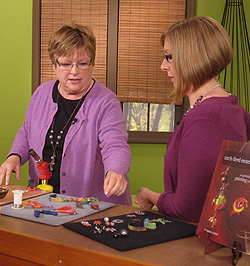 |
